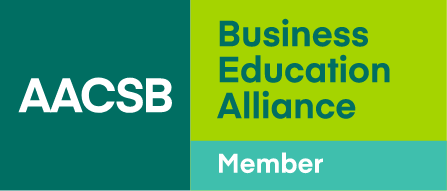Ideas Flourish Among Academics and Practitioners at AACSB’s Co-Lab
What happens when over a hundred business educators and practitioners convene in one place for 36 hours to talk with each other about the possibilities of collaboration? That’s what AACSB International sought to find out at our first conference dedicated to bringing together these two groups, Co-Lab: Connecting Business Schools With Practice, held last week in Atlanta, Georgia.
Imagine a roomful of business school faculty and administrators mingling with business leaders from some of the most successful companies across the globe. What do they talk about? What questions do they ask in this setting ripe for brain-picking and networking? What are the elevator speeches that were carefully thought up for this event, the pitches for partnerships? What are the barriers preventing collaboration, the examples of success? I was fortunate to get a seat at the table—or tables—which allowed me to hear these conversations up close and better understand the prominent issues schools and businesses encounter in trying to partner with one another.
Brainstorming the Challenges
In workshop-style sessions, attendees exchanged ideas through small and large group discussions that at times became quite spirited; there were many voices to be heard, and the format of the conference allowed the opportunity for everyone to speak up. Attendees from business represented public, private, and nonprofit interests, and academics came from small and large schools across seven countries. Throughout the participants’ interactions, common themes arose from both groups as to the challenges they each face and potential solutions. While the confines of this post do not allow a full review of the issues brought up, three main challenges seemed to echo throughout the sessions:
1. Communication, Communication, Communication. During the opening discussion starter, Jason Parton, director of the Statistics Research and Consulting Lab from the University of Alabama, identified communication as one of the primary ways that relationships between schools and companies can flourish. Parton has experience in creating and managing partnerships between his school and industry. He said that keeping in touch with industry and having an open, ongoing relationship is essential to working together. Some of the significant problems that can arise in existing partnerships are when deliverables are not clearly communicated and each party doesn’t have a solid understanding of the other’s motivations and influences as they relate to development concerning their respective environments. As a possible solution, Parton suggested that organizations have a partnership organization or “hub” housed within schools, to act as a hybrid for connecting industry with academia and assist both sides understand their differences in operations and better be able to work collaboratively.
On the industry side, Kerry Tassopoulous, vice president of government relations and compliance at Mary Kay Inc., said that he would like to see a central point of contact at an institution, with whom to begin discussions. The communication center is not clear, and administrative structures differ greatly across colleges and universities. The same feeling was true for schools, according to some vocal b-school representatives at sessions later in the conference; it often isn’t evident where they should begin outreach efforts with companies. In reply, Tassopoulous said their efforts should be targeted to the top executive in one of three offices, depending on the structure of the organization: marketing/branding, human resources/talent development, external relations/public relations.
2. Data Access and Usage. The issue of academics gaining access to company data is a big and complicated one. Attendees brought it up multiple times throughout the conference and in the context of different session topics. Academics want access to the data to use in their research, for potential publication, as well as in classrooms for students to have exposure to real-world business problems. Companies want to keep their data private, so as not to give any advantages—real or perceived—to business competitors. The opportunity, then, for students to work with this data—via live case competitions, internships, or other experiential learning models—is diminished. So, too, is the potential for academics to publish applied research.
Diane McNulty, associate dean of external affairs and corporate development at the University of Texas at Dallas, commented that schools need to be able to identify the ROI for businesses. How can schools sell the benefits of data access to companies facing security and proprietary concerns? Director of HR knowledge and insights at The Coca-Cola Company, Karmen Bentley Blue, said there has to be shared value between the academic researchers/workers and the company providing data, an alignment on critical topics. Companies also want to know what is cutting-edge in research that could benefit company operations. It seems there is plenty of need and desire for both parties to work together, but finding the right methods for doing so and identifying the mutual benefit continues to be a challenge we all need to work to address.
3. Research Relevance. Access to data is just one small part of the research challenge. The research-practice divide was strongly felt among these two groups of conference attendees. Participants voiced different perspectives on what they felt the specific hurdles were. Some business school representatives believed the tenure and promotion process is what prevents faculty from producing research applicable to business practice; the requirement at some schools to publish theory-oriented research in “top”-ranked journals leaves little, if any, room for applied research—which is valued very differently by academia and by business. Some argued that the journal ranking process itself should be done away with.
In her session on Research Collaboration Opportunities, BNSF Railway Endowed Professor of Leadership at Texas Christian University, Mary Uhl-Bien, discussed the language barrier that exists between academic publications and business needs. Someone suggested a translation software (that truly exists) that could interpret theory into practical language; however, Uhl-Bien said that the core of the issue isn’t translation—it’s the way the problem is presented in the first place. Research at its inception needs to be set up to solve real business problems, not theoretical hypotheses. Bentley Blue of Coca-Cola continued this thinking and said that perhaps business schools need to be asking to what end research is published in scholarly journals? If not to solve business problems, then why?
Where We Go From Here
If there’s one takeaway that reverberated louder and clearer than anything else at the conference, it’s that we need more Co-Labs—more opportunities for business school and industry leaders to come together and talk, to flesh out ideas and understand what the possibilities and limitations are so they can optimize the value they each provide to each other and society. We need to emulate the successes of those who are getting it right, build accessible environments in which to share the successes, and keep having the difficult discussions—but make them easier to have.
For AACSB, this is just the beginning of our efforts to aid in the collaborations between business and practice. We recognize that this intersection is a key value item for the AACSB Global Network, consisting of schools, businesses, and society globally. We will continue to listen and to work toward solutions that make partnering simpler and more beneficial for everyone involved.




